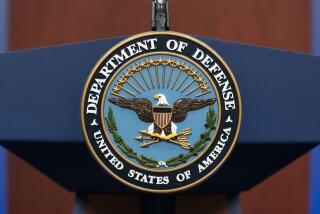Navy Redeployment to Cut Persian Gulf Force
- Share via
WASHINGTON — The United States, citing increased success in combatting Iranian mines and greater cooperation in the region between Washington and its allies, is beginning a Navy redeployment in the Persian Gulf that will result in a net reduction of as many as three ships, a senior Pentagon official said Tuesday.
The decrease in the Middle East naval force signals no change in the American commitment to protect U.S.-flagged ships, said Richard L. Armitage, assistant secretary of defense for international security affairs.
“We’re able to provide the same level of protection with a smaller number of ships,” Armitage said, adding that the operation already has begun with the departures of the battleship Iowa and two escorts from the Arabian Sea. The planned reductions of ships, as well as men and helicopters, “has nothing to do with budget squeezes,” he added.
It has been known for some time that the Administration was seeking ways to reduce its forces in and around the Persian Gulf. To meet a goal of cutting about $11.5 billion from the fiscal 1989 Navy budget, for instance, the service will have to pare its fleet by 16 ships and its planned force of sailors by as many as 10,000.
In all, the Defense Department will slash $33 billion from its original budget blueprint for fiscal 1989. The final Pentagon request, to be disclosed by President Reagan when he announces the Administration’s entire budget proposal Thursday, will amount to about $300 billion.
But defense officials insisted that the reduction in the Persian Gulf force was not imposed by budgetary considerations and does not diminish the Administration’s commitment in the region.
‘Rule of Warfare’
“Economy of force is a basic rule of warfare. It is just good planning,” Armitage said.
The Administration began providing military escorts for U.S.-registered Kuwaiti tankers last July to underscore its commitment to ensuring the flow of oil from the Persian Gulf. Although no American servicemen have been killed in the operation, the policy has been widely criticized as a dangerous increase of U.S. military presence in the region.
U.S. naval forces have ferried 36 convoys through the gulf at a monthly cost of about $20 million, according to the Pentagon. The monthly expense was cut by $5 million recently when Kuwait began providing fuel free of charge.
Under the redeployment plan, the Alameda-based aircraft carrier Enterprise and its eight escort ships will replace the carrier Midway and its seven escort ships in the Arabian Sea by March. The Enterprise will give the reduced force a greater combat capacity than the World War II-vintage Midway because it can accommodate more jets, Armitage said.
In addition, the amphibious ship Okinawa, one of two vessels that have served as bases for six Sea Stallion minesweeping helicopters, is to return to its home port of San Diego without being replaced.
The arrival of five wooden-hulled minesweeping ships, in addition to expanded cooperation among the North Atlantic Treaty Organization allies in hunting and destroying mines, has dispensed with the need for the minesweeping helicopters, Armitage said.
The command ship La Salle, from which the escort operations have been run, will be replaced by the auxiliary ship Coronado, whose home port is Pearl Harbor.
From 33 to 25
The planned rotations could cut the number of ships in the Mideast force to 25, down from a high point of 33 ships in November.
Defense officials have said that the U.S. forces would not leave the Persian Gulf until the military threats to commercial shipping had abated. Iran appears to be laying fewer mines, Armitage said, leaving small-boat attacks as the principal threat.
At the same time, however, Iran is flying its combat aircraft again after a long hiatus, a renewed military threat that could be especially dangerous, Armitage said.
With the Iranian air force flying its American-supplied F-5 and F-14 warplanes again, the gulf air war could escalate and result in more challenges to the U.S. carrier-based jets patrolling the waterway, defense officials said.
Aircraft of the Iraqi air force are also one of the deadliest threats to gulf shipping. U.S.-flagged ships have generally been exempt from Iraqi attacks. Last May, however, an Exocet missile fired from an Iraqi jet, apparently in error, slammed into the U.S. frigate Stark, killing 37 sailors.
More to Read
Sign up for Essential California
The most important California stories and recommendations in your inbox every morning.
You may occasionally receive promotional content from the Los Angeles Times.













